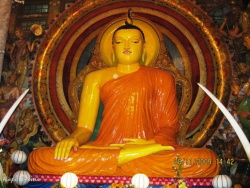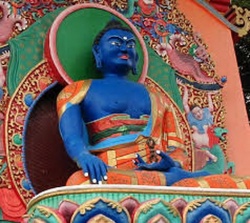Vajrayana Sects (Schools)
There are two major divisions of vajrayana or esoteric Buddhism–the Chinese Chen-yen Tsung or the Japanese Shingon that evolved from the Chinese and the various Tibetan traditions. The practice of esoteric Buddhism in Tibet followed six major traditions: the Nyingma, Jonang, Sakya, Kadampa-Geluk, Shangpa Kagyu, and the Karma (Marpa) Kagyu.
Sometimes the Tibetan religious traditions are classified according to three time periods:
I. Bon: Pre-Buddhist indigenous shamanic tradition that has continued to evolve and assimilate many Buddhist concepts and practices. Many of the local Bon deities became the dharma protectors of esoteric Buddhism in Tibet.
II. Kama or Nyingma: An ancient tradition based on knowledge transmitted during the Tibetan imperial period from the 8th to the 9th century. This era is known as the “early dissemination” or the initial period when tantras were translated from Sanskrit into Tibetan. During this time, the ancient tantras were brought to Tibet, arranged and translated under the direction of the Tibetan King Trisong Deutsen, the Indian Abbot Shantarakshita, and the Kashmiri Master Padmasambhava.
III. Sama or New [[Traditions]] of the Sakya, Kagya, Jonang, and Geluk: These traditions originated during the late 10th century through the 13th century. They consists of the various cycles of tantras, commentaries, and meditation guidance texts that were translated during this later dissemination.
Another way of considering these traditions is to understand the Eight Chariots that they used in their Buddhist practice. Any given practitioner might combine elements from any or all of these Chariots or Methods. Different sects have slightly different ways of organizing or explaining them. There currently exists no encompassing exegesis of the unique meanings and differences between similar terms used in each of the different contexts of the Eight Lineages, although there are scholars working on developing a Compendium of Buddhist Terminology.
1. The Ancients (Nyingma): The doctrinal lineage of Kama or the Ancient Translation School, it consists of a collection of many related but distinct lineages tracing descent from Padmasambhava and earlier practices, the most well-known being the three highest yogas or inner tantras of Mahayoga, Anuyoga, and Atiyoga (Dzogchen).
2. The Precious Words or Discourses of the Lord (Kadam): Based on the Lam Rim (Stages of the Path) teachings and the simple, down-to-earth yet extremely profound practices of Tonglen (sending and receiving) and Lojong (mind training) that were introduced from Bengal by the founder of the lineage, Lord Atisha. This tradition is also known for its renewal of commitment to Vinaya (ethics and monastic rule) including the practice of bodhicharya (celibacy.) Most famous for the propagation of and accomplishments in Father Tantras such as the Guhyasamaja.
3. Path and Fruition or Path Including Results (Lam Dre-Sakya): These teachings present a view of “Clarity and Emptiness free from apprehension” and teaches the “non-differentiation of samsara and nirvana.” They emphasize three tantras of Heruka, Vajrayogini, and Vajrakilaya.
4. Oral Tradition of Marpa (Karma Kagyu): Consists mainly of the practice of Essence Mahamudra, employing yidam practices of Vajrayogini/Vajravarahi, Chakrasamvara, Gyalwa Gyamtso (Red Chenrizig) and Hevajra. It also includes the Six Yogas of Naropa.
5. Oral Tradition of the Shangpa (Shangpa Kagyu): This practice consists mainly of the Chakrasamvara tantra and the Six Dharmas of Niguma.
6. Kalachakra or Jok Druk (Jonang): Famous for the Kalachakra and its Six Yogas, also referred to as the Six-fold Vajra Yoga instruction lineage. It also promotes the shentong view of Madhyamika.
7. Shijey (Ziji)-Chod: Pacifying and cutting practices of Phadampa Sangye and Machik Lapdron, often used on long-term retreats or as part of various preliminary practices.
8. Approach & Accomplishment of the Three Vajras or Urgyen Nyengpa: Also known as the Three-Vajra Lineage, it is the last meditative system to come to Tibet from India. It is also known as the Great Mahasiddha and Yogi Orgyenpa Rinchenpal’s Lineage, who is said to have received its teachings directly from the celestial being Vajrayogini or Vajravarahi,.


